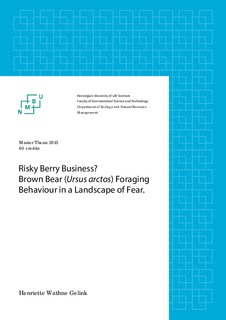| dc.contributor.author | Gelink, Henriette Wathne | |
| dc.date.accessioned | 2016-04-01T07:58:47Z | |
| dc.date.available | 2016-04-01T07:58:47Z | |
| dc.date.issued | 2016-04-01 | |
| dc.identifier.uri | http://hdl.handle.net/11250/2383493 | |
| dc.description.abstract | Mobile animals are expected to optimize their diet and foraging strategies, and balance the cost of resource gain with the perceived predation risk, and therefore trade-off risky areas for safer areas with fewer resources. Large carnivores have few natural enemies and their mortality, forage behaviour, and response to risk are mostly related to human induced disturbances. Scandinavian brown bears feed exclusively on berries during late summer and autumn to gain sufficient carbohydrates to survive hibernation. The purpose of this thesis was to predict spatiotemporal berry availability and whether berry availability created a temporal “blue/red wave” across the berry season. I analysed how bear selection for berries was influenced by various anthropogenic structures and whether bears treaded-off good berry areas for poor berry areas further away from anthropogenic structures. Both bilberries and lingonberries were included in the analysis. | nb_NO |
| dc.language.iso | eng | nb_NO |
| dc.publisher | Norwegian University of Life Sciences, Ås | |
| dc.rights | Navngivelse-Ikkekommersiell-IngenBearbeidelse 3.0 Norge | * |
| dc.rights.uri | http://creativecommons.org/licenses/by-nc-nd/3.0/no/ | * |
| dc.title | Risky berry business? : brown bear (Ursus arctos) foraging behaviour in a landscape of fear | nb_NO |
| dc.type | Master thesis | nb_NO |
| dc.subject.nsi | VDP::Mathematics and natural science: 400::Zoology and botany: 480::Ecology: 488 | nb_NO |
| dc.source.pagenumber | 66 | nb_NO |
| dc.description.localcode | M-ECOL | nb_NO |

